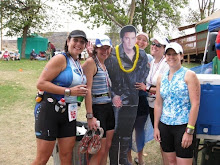Triathlete magazine
In March 2008, I ran a marathon for the first time in four years. The long hiatus was due to a maddening series of overuse injuries. During most of the four years between marathons I doubted I would ever again be able to train at a high level in this discipline, and indeed I quit running in despair at least half a dozen times.
What got me over the hump? It was not a single, all-encompassing cure. Since running-related injuries affect most triathletes, I would like to take this opportunity to share with you four key pieces of my injury-prevention puzzle.
First Piece: Targeted Stretching
Much has been made of recent research demonstrating that routine stretching does not prevent overuse injuries in endurance athletes. While it may be true that a general stretching routine does not prevent injuries in general, certain specific injuries are caused in part by abnormal tightness in particular muscles and tendons. Stretching everything is a little like trying to true a wheel by loosening the spokes on both sides. Stretch only what's too tight and you'll see better results.Second Piece: Corrective Strength Training
Knee pain in runners is often linked to weakness in the hip abductors (the muscles that keep your pelvis from tilting laterally when you're supported by only one leg) on the affected side. A simple test you can use to determine whether your hip abductors are weaker on one side is to perform a single-leg squat with each leg.As you lower your butt toward the floor, eventually your thigh will rotate inward, swinging your hip outward, which is a sign that your hip abductors have become overwhelmed and need help from other muscles. If this compensatory action happens earlier on one side than on the other, that side is weaker and you are more prone to knee pain in the corresponding knee.
I started to even out the strength of my hip abductors by doing single-leg squats, step-ups and other such exercises three times a week, challenging my right side more than my left so that the gap steadily closed.
Third Piece: Gait Retraining
Conventional wisdom holds that the running stride you're born with is the one you're stuck with. But the conventional wisdom is wrong. Recent research has shown that particular running-related overuse injuries can be overcome by making key modifications to one's stride.The most common injury-causing stride flaw is overstriding, or landing heel first with your foot well ahead of your body's center of gravity, instead of landing flat-footed with your foot directly underneath your head. A simple way to correct his flaw is to tilt your entire body very slightly forward from the ankles (not the waist) as you run, as though you're constantly falling forward or running downhill.
This little tweak forces your foot to land flatter and closer to your center of gravity. Correcting the overstriding flaw makes it easier to maintain proper stability in your hips and pelvis on impact and reduces the likelihood of injuries, including iliotibial band friction syndrome and runner's knee.
Fourth Piece: High-tech Nutrition
Remarkably, doctors still do not know exactly what runner's knee is. They used to think it was chondromalacia, or damage to the knee cartilage, but many runners with chondromalacia run pain-free, and many runners with knee pain don't have chondromalacia.The latest theory is that runner's knee, or patellofemoral pain syndrome, is caused by the body's failure to fully repair trauma suffered during runs by the patella and the fat pad underneath it. Every runner experiences such trauma in every run, but some runners (especially those who overstride and have weak hip abductors) incur more than others, and the more you run, the less likely it is that the affected tissues will achieve complete homeostasis between runs.
By changing my shoes, strengthening my hip abductors and retraining my gait, I succeeded in reducing the amount of damage my right knee suffered during a run. Thus, I was able to run more before the pain became debilitating. But I still wasn't able to run enough.
The final piece of the puzzle: I needed some means of repairing the damage more quickly between runs. I found this in a special supplement called hyperimmunized milk factor (HIMF). HIMF is a collection of anti-inflammatory proteins derived from cow's milk. By reducing post-workout inflammation, it facilitates faster tissue repair in athletes for whom inflammation has become chronic.
As yet there are only a couple of HIMF supplements on the market: MicroLactin, which is marketed mainly to arthritis patients, and RX-98, which combines HIMF with a whey protein isolate and is made specifically for athletes.
The Real Cure
Earlier in this article I said that there was no single, all-encompassing cure for my injury woes. But it might be better to say that the true cure was research and experimentation. Once completed, the injury-prevention puzzle looks a little different for each athlete, but the only way for any athlete to put it together is by making an unflagging effort to dig up measures that are worth trying and giving each a fair try.Active Expert Matt Fitzgerald is the author of several books on triathlon and running, including Brain Training for Runners and Runner's World Performance Nutrition for Runners (Rodale, 2005).





















No comments:
Post a Comment